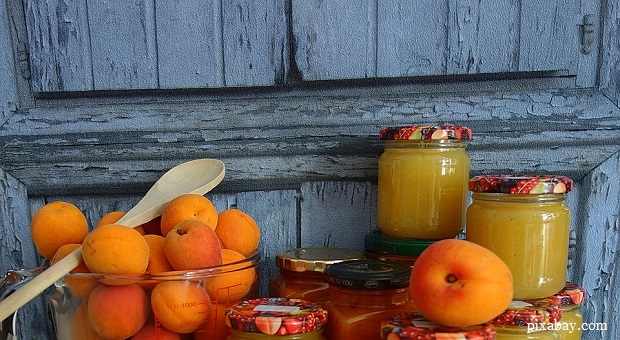You have to love autumn. The leaves are changing, the air is cooling down, and the joy of the holiday season is right around the corner.
Fall is also a time to do your canning in preparation for winter. Now, if you live on a farm, you have to harvest what you have and can it, but if you’re an urban prepper who has to buy produce, then you have to plan a little better.
Unlike a farm garden that likely provides months, if not years, of food, urban preppers have to decide how much food will be necessary to get through the winter.
Then they have to decide how much you need to can based on how much space you have, how much money you have to spend on produce, how much time you have, and how much you want to invest in store-bought goods.
Then of course, you have to figure out what’s available.
So, let’s talk a little about what you need to do to optimize your fall canning plan.
These Are The Ingenious Recipes That Helped Our Ancestors Stay Alive!
Determine What’s Available
This is the first step that you need to take before making any kind of plans at all. Are you planning on making blueberry pie filling or strawberry jam? If so, you’re out of luck if you’re planning on sourcing your produce locally. Both of those are spring and summer crops and are already done for the season.
Blueberries peak in the spring in Florida, so I can’t find them locally now. Even though strawberries grow in some places as late as November, they’re a summer fruit and peak season for them is May and June, so you may have problems finding them locally. My point is to keep an eye on the seasons for the produce that you want to can.
Prioritize
As awesome as it would be to have unlimited space to store canned goods and unlimited funds to buy the produce, that’s not the reality for most of us. So, we have to decide what you want to can and what you’re willing to buy.
I would suggest making a list of foods that you eat the most during the winter months. Spaghetti, salsa, jalapeno peppers, pickles, vegetable or vegetable beef soup. Apple pies, apple sauce, strawberry jelly. Green beans, chili. Choose what you eat the most. Then decide how often you eat them.
Say you eat spaghetti once a week and there are four people in your family. You need at least a pint, if not a quart, or sauce for each time. It’s easy to figure – do you use the whole jar of Prego when you make spaghetti? If so, you use a quart.
Now, knowing that, go through and organize the foods you eat the most and figure out how much of them you need to get you through three months, six months, and a year.
Now that you know that eat a quart of spaghetti sauce a week, that’s four a month, which means 12 quarts in 3 months, 24 quarts in 6 months, and 48 quarts in a year. Remember that this is planning to eat it every single week. If there’s a pretty decent likelihood that you’ll skip a week here and there, then dial those numbers back by a few jars.
Now do the same with each of your top foods. And don’t forget the apple pie filling. As a matter of fact, include enough to give away few jars at Christmas! J
After you know what and how much you eat, it’s time to do a space analysis. Do you have enough space to store all of that for the amount of time that you want to cover? If not, it’s time to do two things. First, pick the ones that you absolutely want to can.
Maybe you have a favorite peach crisp recipe and store-bought peaches just won’t do. Nor, for that matter, is it easy to find canned peach pie filling. You have to buy canned peaches and it’s just not the same. Maybe you can’t stand the taste of mushy store-bought green beans. Put these must-have items at the top of your list.
Now that you’ve pared down the list, you have two options. You can make enough of those favorite items to get you through till next fall, or you can pick some items off of the non-must-have list to fill in some spaces to get you through a shorter time period. This is a good plan if you’re stocking up for a set amount of time, for instance, you want to have three months of food stockpiled.
Finally, you need to go through the non-essential list and decide which items are cheaper to buy at the store. I do love home-canned green beans, but unless they’re on your must-have list, I’d buy them at the store. It’s cheaper, especially if you use coupons, and it’s more efficient for you. It leaves you time to peel all those apples or blanch the tomatoes.
That’s one of the primary skills that you need to develop as an urban prepper – the value of store-bought over home-canned. You have limited space and, unfortunately, can’t grow thirty tomato plants for $20 like a rural prepper can so you have to take cost into consideration. That’s going to vary by location; for instance, I can buy cheap citrus fruits and strawberries dirt cheap because they’re grown right here.
Most of the non-citrus tree fruits, on the other hand – peaches, apricots, apples, cherries – are crazy expensive because they don’t grow down here.
Personally, I always choose to can tomatoes and apples if I can find them in bulk (sort of) at one of my local farmers markets because tomatoes are versatile – soups, sauces, salsas – and apples are expensive.
I also can entire meals in a jar, including vegetable soup, so that all I have to do is pour it in a pan and heat it up on nights that I don’t feel like cooking. As a matter of fact, a lot of my canned goods are either ready to eat or close enough.
Source
Now that you have an idea of what you want to can and what’s in season, you need to find a source. Honestly, I found my favorite two farmers markets and my U-Pick blueberry/strawberry farm on Facebook and by Googling “farmers markets near me.” A lot of times, you can also find them under community events if you go to your town’s website.
Look around at other towns that are within driving distance. If you live in a city but more rural places are within an easy drive, search those places too. It’s a guarantee that food is going to be cheaper at rural, local farmers markets. And you may find a food co-op, too. Score!
Finally, the best source of organic, safe food is … you. Do some container gardening. You’d be surprised by how many tomatoes you can grow right on your porch or balcony, and strawberry hangers are adorable. Plus, that’s basically free food.
Urban prepping is tough – a lot tougher than being a country prepper. I know, because I’ve been both. I worked harder when I lived on the farm, but I was also in better shape and had a real sense of accomplishment every time I popped open a jar of jam or sliced up a fresh jalapeno pepper for my homemade salsa. And those fresh eggs and milk!
But, that’s not my life right now, so I, like you, do the best I can to eat healthy foods and prepare myself for emergencies given my current living arrangements. And I look at it this way – I’ve learned a ton because I’ve had to be resourceful, and even when I make it back to the country, I won’t be doing things the way I used to! Raised beds, container gardening – yeah, those tricks are going with me for sure!
Good luck with your fall canning and if you have any questions or comments, please share in the comments section below.
This article has been written by Theresa Crouse for Survivopedia.











Gwenda Moore | September 7, 2017
|
We live in Southwest Texas with no way to cool without refrigeration. I have visions of exploding bottles and don’t see how we can can. Should we move to the water or will canning lids just quickly rust in tthere?